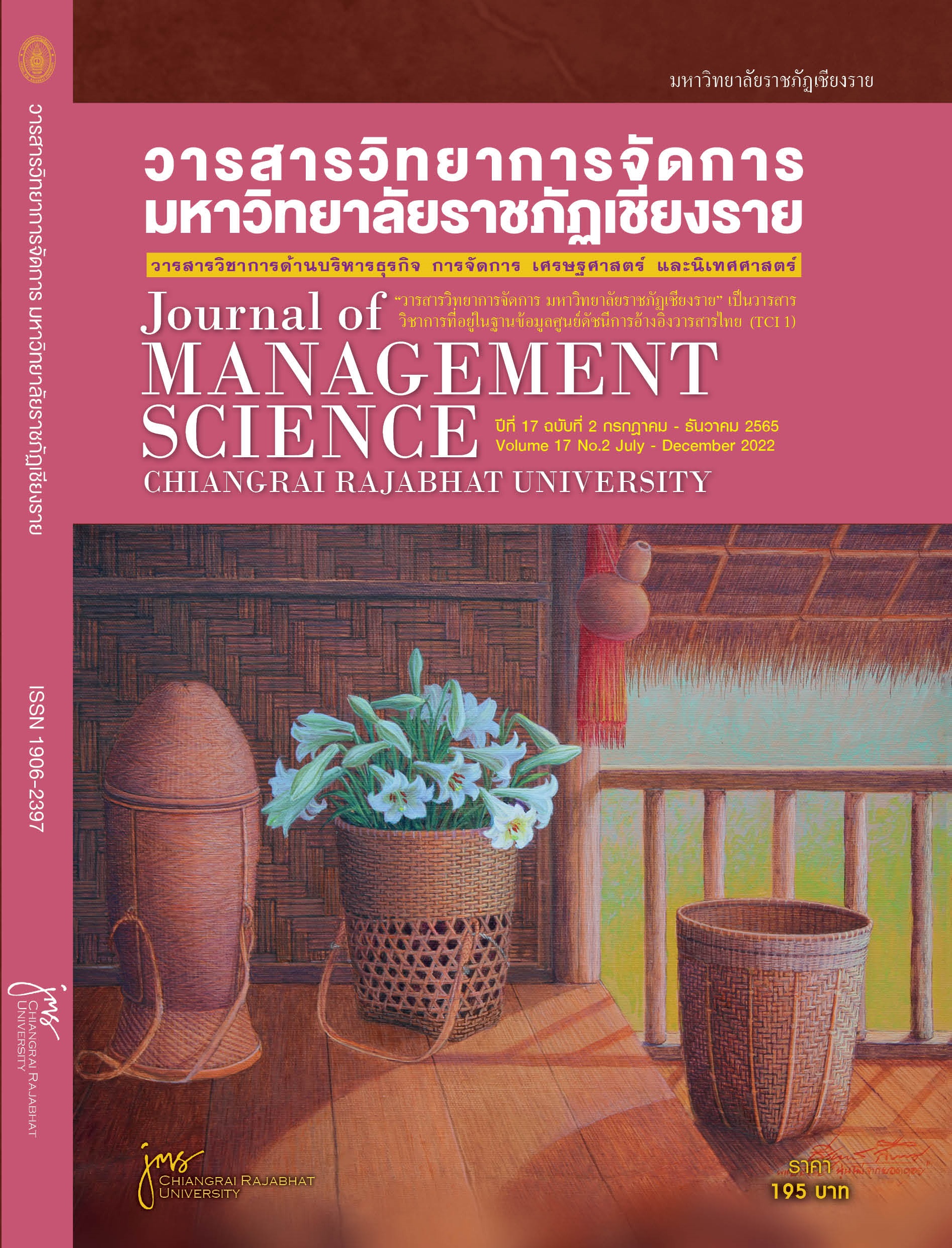Cultural Dimensional and Marketing Mix Factors Affecting the Travel Behavior in Japan of Thai tourists
Main Article Content
Abstract
This study aims to study tourism behavior, cultural dimensional and marketing mix factors as well as studying the relationships of such factors that affect the travel habits of Thai tourists in Japan. The sample used was 407 Thai tourists who had visited Japan and the data was collected with questionnaires. The data was analyzed with frequency, percentage, average, standard deviation and test hypotheses with a one-way ANOVA test at a statistical significance level of 0.05. The results showed that the sample traveled to Japan for the first time to relax/travel with family/relatives, manage all self-guided trips, stay in hotels and find information via website/online/social media. The trips cost between 20,001-40,000 baht and nearly all tourists will return to Japan in the future. Tourists have an opinion on the cultural dimensional factors and marketing mix factors which are high and very high, respectively. Especially on issues of humility and the environment relating to tourist attractions. Hypothesis tests showed that cultural dimensional factors were associated with tourism behavior in the field of number of trips, purpose of trips, travel companions, travel arrangements, accommodation type, how to find information and expenses. Marketing mix factors are associated with tourism behavior in Japan in terms of the tourism purposes, travel companions, travel arrangements, how to find information and expenses.
Article Details

This work is licensed under a Creative Commons Attribution-NonCommercial-NoDerivatives 4.0 International License.
Views and opinions expressed in the journal do not necessarily reflect those of the editors.
References
Chaipunha, S., & Sriprasert, U. (2016). Concept, Culture Management Theory: Adaptation under the cultural differences. Management Science Rajaphat Maha-Sarakham University Journal. 1(2), 104–116. (in Thai).
Cronbach, L. J. (1970). Essential of Psychological testing (3rd.). New York : Harper and Row.
Foreign Workers Administration. (2014). Statistics on international labour migration. Retrieved January 17, 2022, from https://www.doe.go.th/prd/alien/statistic/param/site/152/cat/82/sub/0/pull/category/view/list-label. (in Thai).
Hawkinson, E. (2013). Social Media for International Inbound Tourism in Japan: A Research Model for Finding Effective eWOM Mediums. JAFIT international tourism review. 20, 41–48.
Hofstede, G., Hofstede, G. J., & Minkov, M. (2010). Cultures and Organizations: Software of the Mind. New York : McGraw-Hill.
Japan National Tourism Organization. (2021). Number of international visitors to Japan and Number of Japanese Overseas Traveler. Retrieved January 1, 2022, from https://www.mlit.go.jp/kankocho/siryou/toukei/in_out.html.
Khunon, S. (2016). Cultural Dimensions and Hotel Commentating via Online Travel Agent Websites of Thai and Other National Customers: Samui Island. Journal of Thai Hospitality and Tourism. 11(1), 53-68. (in Thai).
Kopatta, C. (1996). Japan and The Siam Society: Thailand and Japan Relations in Decade 1927-1937. Japanese Studies Journal Thammasat University. 13(2), 88–119. (in Thai).
Kotler, P. (1997). Marketing Management: analysis, planning, implementation and control (9th ed.). New Jersey : A Simon & Schuster.
Kuo, I. H., Liu, E. K. & Chen, C. C. (2012). Modeling Japanese Tourism Demand for Asian Destinations: A Dynamic AIDS Approach. Retrieved January 1, 2022, from https://www.tandfonline.com/doi/abs/ 10.1080/10941665.2012.726926?journalCode=rapt20
Likert, R. (1961). New Patterns of Management. New York : McGraw-Hill Book Company Inc.
Malai, V. (2008). Cultural Difference and Tourism behaviour. Executive Journal. 28(2), 86-89. (in Thai).
Maslow, H. A. (1970). Maslow's Hierarchy of Needs. Retrieved January 17, 2022, from https://www.simplypsychology.org/maslow.html.
Matsuoka, K. (2017). Examining the Effects of Perceived Quality, Value, Satisfaction, and Destination Loyalty in Shiogama, Japan. Retrieved January 17, 2022, from https://www.researchgate.net/publication/339375320_
Examining_the_Effects_of_Perceived_Quality_Value_Satisfaction_and_Destination_Loyalty_in_Shiogama_Japan.
Muangsan, U. (2019). Cultural Difference Perception Influencing Thai Business’s Service Management for Middle Eastern Tourists. Social Science Journal of Prachachuen. 1(3), 38-50. (in Thai).
Ohkubo, R., & Muromachi, Y. (2014). A Study of Destination Images of Foreign Tourists to Japan by Analyzing Travel Guidebook and Review Site. Journal of the City Planning Institute of Japan. 49(3), 573–578.
Rayubsri, W. (2006). Buddhist tourism habits of Thai and foreign tourists visiting temples in Rattanakosin Island Bangkok. Retrieved January 1, 2022, from https://opac.kku.ac.th/Catalog/BibItem.aspx?BibID=b00308060. (in Thai).
Soonsan, N., Sangthong, S., & Sungthong, S. (2020). Factors Influencing Tourists’ Revisiting Intention: The Western Tourists’ Perspective Travelling in Phuket. Retrieved January 17, 2022, from https://so01.tci-thaijo.org. (in Thai).
Wiyaporn, W. (2020). Guildlines for Development Pattaya to Sustainable Shopping Tourism City of Mainland Chinese Tourists. Rajabhat Chiang Mai Research Journal. 21(3), 228-249. (in Thai).
Yamane, T. (1970). Statistic: Introductory Analysis (2nd ed.). New York : Harper and Row.


